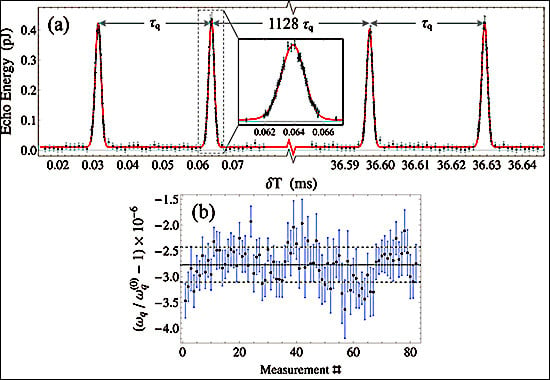Prospects for Precise Measurements with Echo Atom Interferometry
Abstract
:1. Introduction
1.1. Description of Raman-Type Interferometers
1.2. Description of Grating-Echo-Type Interferometers
2. Measurements of Atomic Recoil Frequency
2.1. Introduction
2.2. Description of the Modified Three-Pulse AI
2.3. Experimental Setup
2.4. Results
2.5. Discussion of Systematic Effects
3. Measurements of Gravitational Acceleration
3.1. Overview of Gravity Measurements
3.2. Description of Echo AI Techniques for Measuring g
3.3. Experimental Setup
3.4. Theory
3.4.1. Two-Pulse AI
3.4.2. Three-Pulse AI
3.5. Results
3.5.1. Doppler Phase Measurements
3.5.2. Two-Pulse AI Measurement
3.5.3. Three-Pulse Measurement
3.6. Improvements and Future Work
4. Magnetic Coherences
5. Auto-Locked Lasers
6. Conclusion
Acknowledgments
Author Contributions
Conflicts of Interest
References
- Moskowitz, P.E.; Gould, P.L.; Atlas, S.R.; Pritchard, D.E. Diffraction of an Atomic Beam by Standing-Wave Radiation. Phys. Rev. Lett. 1983, 51, 370–373. [Google Scholar] [CrossRef]
- Gould, P.L.; Ruff, G.A.; Pritchard, D.E. Diffraction of Atoms by Light: The Near-Resonant Kapitza-Dirac Effect. Phys. Rev. Lett. 1986, 56, 827–830. [Google Scholar] [CrossRef] [PubMed]
- Keith, D.W.; Ekstrom, C.R.; Turchette, Q.R.; Pritchard, D.E. An Interferometer for Atoms. Phys. Rev. Lett. 1991, 66, 2693–2696. [Google Scholar] [CrossRef] [PubMed]
- Carnal, O.; Mlynek, J. Young’s Double-Slit Experiment with Atoms: A Simple Atom Interferometer. Phys. Rev. Lett. 1991, 66, 2689–2692. [Google Scholar] [CrossRef] [PubMed]
- Schmiedmayer, J.; Chapman, M.S.; Ekstrom, C.R.; Hammond, T.D.; Wehinger, S.; Pritchard, D.E. Index of Refraction of Various Gases for Sodium Matter Waves. Phys. Rev. Lett. 1995, 74, 1043–1047. [Google Scholar] [CrossRef] [PubMed]
- Weiss, D.S.; Young, B.C.; Chu, S. Precision Measurement of the Photon Recoil of an Atom using Atomic Interferometry. Phys. Rev. Lett. 1993, 70, 2706–2709. [Google Scholar] [CrossRef] [PubMed]
- Riehle, F.; Kisters, T.; Witte, A.; Helmcke, J.; Bordé, C.J. Optical Ramsey spectroscopy in a rotating frame: Sagnac effect in a matter-wave interferometer. Phys. Rev. Lett. 1991, 67, 177–180. [Google Scholar] [CrossRef] [PubMed]
- Kasevich, M.; Chu, S. Atomic interferometry using stimulated Raman transitions. Phys. Rev. Lett. 1991, 67, 181–184. [Google Scholar] [CrossRef] [PubMed]
- Berman, P.R. (Ed.) Atom Interferometry; Academic Press: San Diego, CA, USA, 1997.
- Cronin, A.; Schmiedmayer, J.; Pritchard, D.E. Optics and interferometry with atoms and molecules. Rev. Mod. Phys. 2009, 81, 1051–1129. [Google Scholar] [CrossRef]
- Barrett, B.; Gominet, P.A.; Cantin, E.; Antoni-Micollier, L.; Bertoldi, A.; Battelier, B.; Bouyer, P.; Lautier, J.; Landragin, A. Mobile and remote inertial sensing with atom interferometers. In Proceedings of the International School of Physicc “Enrico Fermi”, Vol. 188 “Atom Interferometry”; Tino, G.M., Kasevich, M.A., Eds.; IOS: Amsterdam, The Netherland, 2014; pp. 493–555. [Google Scholar]
- Wicht, A.; Hensley, J.M.; Sarajlic, E.; Chu, S. A Preliminary Measurement of the Fine Structure Constant Based on Atom Interferometry. Phys. Scr. 2002, 2002, 82–88. [Google Scholar] [CrossRef]
- Cladé, P.; de Mirandes, E.; Cadoret, M.; Guellati-Khélifa, S.; Schwob, C.; Nez, F.; Julien, L.; Biraben, F. Determination of the Fine Structure Constant Based on Bloch Oscillations of Ultracold Atoms in a Vertical Optical Lattice. Phys. Rev. Lett. 2006, 96, 033001. [Google Scholar] [CrossRef] [PubMed]
- Cadoret, M.; de Mirandes, E.; Clade, P.; Guellati-Khélifa, S.; Schwob, C.; Nez, F.; Julien, L.; Biraben, F. Combination of Bloch Oscillations with a Ramsey-Bordé Interferometer: New Determination of the Fine Structure Constant. Phys. Rev. Lett. 2008, 101, 230801. [Google Scholar] [CrossRef] [PubMed]
- Bouchendira, R.; Clade, P.; Guellati-Khélifa, S.; Nez, F.; Biraben, F. New determination of the fine structure constant and test of the quantum electrodynamics. Phys. Rev. Lett. 2011, 106, 080801. [Google Scholar] [CrossRef] [PubMed]
- Lan, S.Y.; Kuan, P.C.; Estey, B.; English, D.; Brown, J.M.; Hohensee, M.A.; Müller, H. A Clock Directly Linking Time to a Particle’s Mass. Science 2013, 339, 554–557. [Google Scholar] [CrossRef] [PubMed]
- Bertoldi, A.; Lamporesi, G.; Cacciapuoti, L.; de Angelis, M.; Fattori, M.; Petelski, T.; Peters, A.; Prevedelli, M.; Stuhler, J.; Tino, G.M. Atom interferometry gravity-gradiometer for the determination of the Newtonian gravitational constant G. Eur. Phys. J. D 2006, 40, 271–279. [Google Scholar] [CrossRef]
- Fixler, J.B.; Foster, G.T.; McGuirk, J.M.; Kasevich, M.A. Atom Interferometer Measurement of the Newtonian Constant of Gravity. Science 2007, 315, 74–77. [Google Scholar] [CrossRef] [PubMed]
- Lamporesi, G.; Bertoldi, A.; Cacciapuoti, L.; Prevedelli, M.; Tino, G.M. Determination of the Newtonian Gravitational Constant Using Atom Interferometry. Phys. Rev. Lett. 2008, 100, 050801. [Google Scholar] [CrossRef] [PubMed]
- Rosi, G.; Sorrentino, F.; Cacciapuoti, L.; Prevedelli, M.; Tino, G.M. Precision measurement of the Newtonian gravitational constant using cold atoms. Nature 2014, 510, 518–521. [Google Scholar] [CrossRef] [PubMed]
- Peters, A.; Chung, K.Y.; Young, B.; Hensley, J.; Chu, S. Precision atom interferometry. Phil. Trans. R. Soc. Lond. A 1997, 355, 2223–2233. [Google Scholar] [CrossRef]
- Peters, A.; Chung, K.Y.; Chu, S. Measurement of gravitational acceleration by dropping atoms. Nature 1999, 400, 849–852. [Google Scholar]
- Snadden, M.J.; McGuirk, J.M.; Bouyer, P.; Haritos, K.G.; Kasevich, M.A. Measurement of the Earth’s Gravity Gradient with an Atom Interferometer-Based Gravity Gradiometer. Phys. Rev. Lett. 1998, 81, 971–974. [Google Scholar] [CrossRef]
- McGuirk, J.M.; Foster, G.T.; Fixler, J.B.; Snadden, M.J.; Kasevich, M.A. Sensitive absolute-gravity gradiometry using atom interferometry. Phys. Rev. A 2002, 65, 033608. [Google Scholar] [CrossRef]
- Sorrentino, F.; Bertoldi, A.; Bodart, Q.; Cacciapuoti, L.; de Angelis, M.; Lien, Y.H.; Prevedelli, M.; Rosi, G.; Tino, G.M. Simultaneous measurement of gravity acceleration and gravity gradient with an atom interferometer. Appl. Phys. Lett. 2012, 101, 114106. [Google Scholar] [CrossRef]
- Lenef, A.; Hammond, T.; Smith, E.; Chapman, M.; Rubenstein, R.; Pritchard, D.E. Rotation Sensing with an Atom Interferometer. Phys. Rev. Lett. 1997, 78, 760–763. [Google Scholar] [CrossRef]
- Gustavson, T.L.; Bouyer, P.; Kasevich, M.A. Precision Rotation Measurements with an Atom Interferometer Gyroscope. Phys. Rev. Lett. 1997, 78, 2046–2049. [Google Scholar] [CrossRef]
- Barrett, B.; Geiger, R.; Dutta, I.; Meunier, M.; Canuel, B.; Gauguet, A.; Bouyer, P.; Landragin, A. The Sagnac effect: 20 years of development in matter-wave interferometry. C. R. Phys. 2014, 15, 875–883. [Google Scholar] [CrossRef]
- Dutta, I.; Savoie, D.; Fang, B.; Venon, B.; Alzar, C.L.G.; Geiger, R.; Landragin, A. Continuous Cold-Atom Inertial Sensor with 1 nrad/s Rotation Stability. Phys. Rev. Lett. 2016, 116, 183003. [Google Scholar] [CrossRef] [PubMed]
- Weel, M.; Chan, I.; Beattie, S.; Kumarakrishnan, A.; Gosset, D.; Yavin, I. Effect of a magnetic field gradient and gravitational acceleration on a time-domain grating-echo interferometer. Phys. Rev. A 2006, 73, 063624. [Google Scholar] [CrossRef]
- Davis, J.P.; Narducci, F.A. A proposal for a gradient magnetometer atom interferometer. J. Mod. Opt. 2008, 55, 3173–3185. [Google Scholar] [CrossRef]
- Barrett, B.; Chan, I.; Kumarakrishnan, A. Atom-interferometric techniques for measuring uniform magnetic field gradients and gravitational acceleration. Phys. Rev. A 2011, 84, 063623. [Google Scholar] [CrossRef]
- Hardman, K.S.; Everitt, P.J.; McDonald, G.D.; Manju, P.; Wigley, P.B.; Sooriyabadara, M.A.; Kuhn, C.C.N.; Debs, J.E.; Close, J.D.; Robins, N.P. A quantum sensor: Simultaneous precision gravimetry and magnetic gradiometry with a Bose-Einstein condensate. 2016; arXiv:1603.01967. [Google Scholar]
- Bonnin, A.; Zahzam, N.; Bidel, Y.; Bresson, A. Simultaneous dual-species matter-wave accelerometer. Phys. Rev. A 2013, 88, 043615. [Google Scholar] [CrossRef]
- Müntinga, H.; Ahlers, H.; Krutzik, M.; Wenzlawski, A.; Arnold, S.; Becker, D.; Bongs, K.; Dittus, H.; Duncker, H.; Gaaloul, N.; et al. Interferometry with Bose-Einstein Condensates in Microgravity. Phys. Rev. Lett. 2013, 110, 093602. [Google Scholar] [CrossRef] [PubMed]
- Dickerson, S.M.; Hogan, J.M.; Sugarbaker, A.; Johnson, D.M.S.; Kasevich, M.A. Multiaxis Inertial Sensing with Long-Time Point Source Atom Interferometry. Phys. Rev. Lett. 2013, 111, 083001. [Google Scholar] [CrossRef] [PubMed]
- Sugarbaker, A.; Dickerson, S.M.; Hogan, J.M.; Johnson, D.M.S.; Kasevich, M.A. Enhanced Atom Interferometer Readout through the Application of Phase Shear. Phys. Rev. Lett. 2013, 111, 113002. [Google Scholar] [CrossRef] [PubMed]
- Aguilera, D.; Ahlers, H.; Battelier, B.; Bawamia, A.; Bertoldi, A.; Bondarescu, R.; Bongs, K.; Bouyer, P.; Braxmaier, C.; Cacciapuoti, L.; et al. STE-QUEST—test of the universality of free fall using cold atom interferometry. Class. Quan. Gravity 2014, 31, 115010. [Google Scholar] [CrossRef]
- Schlippert, D.; Hartwig, J.; Albers, H.; Richardson, L.L.; Schubert, C.; Roura, A.; Schleich, W.P.; Ertmer, W.; Rasel, E.M. Quantum Test of the Universality of Free Fall. Phys. Rev. Lett. 2014, 112, 203002. [Google Scholar] [CrossRef]
- Barrett, B.; Antoni-Micollier, L.; Chichet, L.; Battelier, B.; Gominet, P.A.; Bertoldi, A.; Bouyer, P.; Landragin, A. Correlative methods for dual-species quantum tests of the weak equivalence principle. New J. Phys. 2015, 17, 085010. [Google Scholar] [CrossRef]
- Bonnin, A.; Zahzam, N.; Bidel, Y.; Bresson, A. Characterization of a simultaneous dual-species atom interferometer for a quantum test of the weak equivalence principle. Phys. Rev. A 2015, 92, 023626. [Google Scholar] [CrossRef]
- Hartwig, J.; Abend, S.; Schubert, C.; Schlippert, D.; Ahlers, H.; Posso-Trujillo, K.; Gaaloul, N.; Ertmer, W.; Rasel, E.M. Testing the universality of free fall with rubidium and ytterbium in a very large baseline atom interferometer. New J. Phys. 2015, 17, 035011. [Google Scholar] [CrossRef]
- Dimopoulos, S.; Graham, P.W.; Hogan, J.M.; Kasevich, M.A. Testing general relativity with atom interferometry. Phys. Rev. Lett. 2007, 98, 111102. [Google Scholar] [CrossRef] [PubMed]
- Geiger, R.; Amand, L.; Bertoldi, A.; Canuel, B.; Chaibi, W.; Danquigny, C.; Dutta, I.; Fang, B.; Gaffet, S.; Gillot, J.; et al. Matter-wave laser Interferometric Gravitation Antenna (MIGA): New perspectives for fundamental physics and geosciences. 2015; arXiv:1505.07137. [Google Scholar]
- Bordé, C.J. Atom Interferometry With Internal State Labelling. Phys. Lett. A 1989, 140, 10–12. [Google Scholar] [CrossRef]
- Hu, Z.K.; Sun, B.L.; Duan, X.C.; Zhou, M.K.; Chen, L.L.; Zhan, S.; Zhang, Q.Z.; Luo, J. Demonstration of an ultrahigh-sensitivity atom-interferometry absolute gravimeter. Phys. Rev. A 2013, 88, 043610. [Google Scholar] [CrossRef]
- Gillot, P.; Francis, O.; Landragin, A.; Pereira Dos Santos, F.; Merlet, S. Stability comparison of two absolute gravimeters: optical versus atomic interferometers. Metrologia 2014, 51, L15. [Google Scholar] [CrossRef]
- Freier, C.; Hauth, M.; Schkolnik, V.; Leykauf, B.; Schilling, M.; Wziontek, H.; Scherneck, H.G.; Müller, J.; Peters, A. Mobile quantum gravity sensor with unprecedented stability. 2015; arXiv:1512.05660. [Google Scholar]
- Hughes, K.J.; Burke, J.H.T.; Sackett, C.A. Suspension of Atoms Using Optical Pulses, and Application to Gravimetry. Phys. Rev. Lett. 2009, 102, 150403. [Google Scholar] [CrossRef] [PubMed]
- Poli, N.; Wang, F.Y.; Tarallo, M.G.; Alberti, A.; Prevedelli, M.; Tino, G.M. Precision Measurement of Gravity with Cold Atoms in an Optical Lattice and Comparison with a Classical Gravimeter. Phys. Rev. Lett. 2011, 106, 038501. [Google Scholar] [CrossRef] [PubMed]
- Charrière, R.; Cadoret, M.; Zahzam, N.; Bidel, Y.; Bresson, A. Local gravity measurement with the combination of atom interferometry and Bloch oscillations. Phys. Rev. A 2012, 85, 013639. [Google Scholar] [CrossRef]
- Altin, P.A.; Johnsson, M.T.; Dennis, G.R.; Anderson, R.P.; Debs, J.E.; Szigeti, S.S.; Hardman, K.S.; Bennetts, S.; McDonald, G.D.; Turner, L.D.; et al. Precision atomic gravimeter based on Bragg diffraction. New J. Phys. 2013, 15, 023009. [Google Scholar] [CrossRef]
- Andia, M.; Jannin, R.; Nez, F.; Biraben, F.; Guellati-Khélifa, S.; Cladé, P. Compact atomic gravimeter based on a pulsed and accelerated optical lattice. Phys. Rev. A 2013, 88, 031605. [Google Scholar] [CrossRef]
- Barrett, B.; Chan, I.; Mok, C.; Carew, A.; Yavin, I.; Kumarakrishnan, A.; Cahn, S.B.; Sleator, T. Time-Domain Interferometry with Laser-Cooled Atoms. In Advances in Atomic, Molecular and Optical Physics; Arimondo, E., Berman, P.R., Lin, C.C., Eds.; Elsevier Inc.: Amsterdam, The Netherlands, 2011; Volume 60, Chapter 3; pp. 119–199. [Google Scholar]
- Cahn, S.B.; Kumarakrishnan, A.; Shim, U.; Sleator, T.; Berman, P.R.; Dubetsky, B. Time-Domain de Broglie Wave Interferometry. Phys. Rev. Lett. 1997, 79, 784–787. [Google Scholar] [CrossRef]
- Barrett, B. Techniques for Measuring the Atomic Recoil Frequency Using a Grating-Echo Atom Interferometer. Ph.D. Thesis, York University, Toronto, ON, Canada, 2012. [Google Scholar]
- Barrett, B.; Carew, A.; Beattie, S.; Kumarakrishnan, A. Measuring the atomic recoil frequency using a modified grating-echo atom interferometer. Phys. Rev. A 2013, 87, 033626. [Google Scholar] [CrossRef]
- Mok, C.; Barrett, B.; Carew, A.; Berthiaume, R.; Beattie, S.; Kumarakrishnan, A. Demonstration of improved sensitivity of echo interferometers to gravitational acceleration. Phys. Rev. A 2013, 88, 023614. [Google Scholar] [CrossRef]
- Chan, I.; Barrett, B.; Kumarakrishnan, A. Precise determination of atomic g-factor ratios from a dual isotope magneto-optical trap. Phys. Rev. A 2011, 84, 032509. [Google Scholar] [CrossRef]
- Chan, I.; Andreyuk, A.; Beattie, S.; Barrett, B.; Mok, C.; Weel, M.; Kumarakrishnan, A. Properties of magnetic sublevel coherences for precision measurements. Phys. Rev. A 2008, 78, 033418. [Google Scholar] [CrossRef]
- Beica, H.C.; Carew, A.; Vorozcovs, A.; Dowling, P.; Pouliot, A.; Singh, G.; Kumarakrishnan, A. An Auto-Locked Diode Laser System for Precision Metrology. 2016; in preparation. [Google Scholar]
- Bongs, K.; Launay, R.; Kasevich, M.A. High-order inertial phase shifts for time-domain atom interferometers. Appl. Phys. B 2006, 84, 599–602. [Google Scholar] [CrossRef]
- Itano, W.M.; Bergquist, J.C.; Bollinger, J.J.; Gilligan, J.M.; Heinzen, D.J.; Moore, F.L.; Raizen, M.G.; Wineland, D.J. Quantum projection noise: Population fluctuations in two-level systems. Phys. Rev. A 1993, 47, 3554–3570. [Google Scholar] [CrossRef] [PubMed]
- Le Gouët, J.; Mehlstäubler, T.E.; Kim, J.; Merlet, S.; Clairon, A.; Landragin, A.; Pereira Dos Santos, F. Limits to the sensitivity of a low noise compact atomic gravimeter. Appl. Phys. B 2008, 92, 133–144. [Google Scholar] [CrossRef]
- Rocco, E.; Palmer, R.N.; Valenzuela, T.; Boyer, V.; Freise, A.; Bongs, K. Fluorescence detection at the atom shot noise limit for atom interferometry. New J. Phys. 2014, 16, 093046. [Google Scholar] [CrossRef]
- Lan, S.Y.; Kuan, P.C.; Estey, B.; Haslinger, P.; Müller, H. Influence of the Coriolis Force in Atom Interferometry. Phys. Rev. Lett. 2012, 108, 090402. [Google Scholar] [CrossRef] [PubMed]
- Chiow, S.w.; Herrmann, S.; Chu, S.; Müller, H. Noise-Immune Conjugate Large-Area Atom Interferometers. Phys. Rev. Lett. 2009, 103, 050402. [Google Scholar] [CrossRef] [PubMed]
- Müller, H.; Chiow, S.; Long, Q.; Herrmann, S.; Chu, S. Atom Interferometry with up to 24-Photon-Momentum-Transfer Beam Splitters. Phys. Rev. Lett. 2008, 100, 180405. [Google Scholar] [CrossRef] [PubMed]
- Chiow, S.w.; Kovachy, T.; Chien, H.C.; Kasevich, M.A. 102 hk Large Area Atom Interferometers. Phys. Rev. Lett. 2011, 107, 130403. [Google Scholar] [CrossRef] [PubMed]
- McDonald, G.D.; Kuhn, C.C.N.; Bennetts, S.; Debs, J.E.; Hardman, K.S.; Johnsson, M.; Close, J.D.; Robins, N.P. 80hk momentum separation with Bloch oscillations in an optically guided atom interferometer. Phys. Rev. A 2013, 88, 053620. [Google Scholar] [CrossRef]
- Clade, P.; Guellati-Khélifa, S.; Nez, F.; Biraben, F. Large Momentum Beam Splitter Using Bloch Oscillations. Phys. Rev. Lett. 2009, 102, 240402. [Google Scholar] [CrossRef] [PubMed]
- Clauser, J.F.; Li, S. Talbot-vonLau atom interferometer with cold potassium. Phys. Rev. A 1994, 49, R2213–R2216. [Google Scholar] [CrossRef] [PubMed]
- Chapman, M.S.; Ekstrom, C.R.; Hammond, T.D.; Schmiedmayer, J.; Tannian, B.E.; Wehinger, S.; Pritchard, D.E. Near-field imaging of atomic diffraction gratings: the atomic Talbot effect. Phys. Rev. A 1995, 51, R14–R17. [Google Scholar] [CrossRef] [PubMed]
- Berman, P.R.; Malinovsky, V.S. Principles of Laser Spectroscopy and Quantum Optics; Princeton University Press: Princeton, NJ, USA, 2011. [Google Scholar]
- Strekalov, D.V.; Turlapov, A.; Kumarakrishnan, A.; Sleator, T. Periodic structures generated in a cloud of cold atoms. Phys. Rev. A 2002, 66, 023601. [Google Scholar] [CrossRef]
- Beattie, S.; Barrett, B.; Weel, M.; Chan, I.; Mok, C.; Cahn, S.B.; Kumarakrishnan, A. Influence of spontaneous emission on a single-state atom interferometer. Phys. Rev. A 2008, 77, 013610. [Google Scholar] [CrossRef]
- Barrett, B.; Yavin, I.; Beattie, S.; Kumarakrishnan, A. Numerical simulation of a multilevel atom interferometer. Phys. Rev. A 2010, 82, 023625. [Google Scholar] [CrossRef]
- Giltner, D.M.; McGowan, R.W.; Lee, S.A. Atom Interferometer Based on Bragg Scattering from Standing Light Waves. Phys. Rev. Lett. 1995, 75, 2638–2641. [Google Scholar] [CrossRef] [PubMed]
- Gradshteyn, I.S.; Ryzhik, I.M. Tables of Integrals, Series, and Products, 7th ed.; Elsevier: Amsterdam, Netherlands, 2007; p. 940. [Google Scholar]
- Dubetsky, B.; Berman, P.R.; Sleator, T. Grating stimulated echo. Phys. Rev. A 1992, 46, R2213–R2216. [Google Scholar] [CrossRef] [PubMed]
- Gupta, S.; Dieckmann, K.; Hadzibabic, Z.; Pritchard, D.E. Contrast Interferometry using Bose-Einstein Condensates to Measure h/m and α. Phys. Rev. Lett. 2002, 89, 140401. [Google Scholar] [CrossRef] [PubMed]
- Jamison, A.O.; Plotkin-Swing, B.; Gupta, S. Advances in precision contrast interferometry with Yb Bose-Einstein condensates. Phys. Rev. A 2014, 90, 063606. [Google Scholar] [CrossRef]
- Weidmuller, M.; Hemmerich, A.; Gorlitz, A.; Esslinger, T.; Hansch, T.W. Bragg Diffraction in an Atomic Lattice Bound by Light. Phys. Rev. Lett. 1995, 75, 4583–4586. [Google Scholar] [CrossRef] [PubMed]
- Weidemüller, M.; Görlitz, A.; Hänsch, T.; Hemmerich, A. Local and global properties of light-bound atomic lattices investigated by Bragg diffraction. Phys. Rev. A 1998, 58, 4647–4661. [Google Scholar] [CrossRef]
- Slama, S.; von Cube, C.; Deh, B.; Ludewig, A.; Zimmermann, C.; Courteille, P.W. Phase-Sensitive Detection of Bragg Scattering at 1D Optical Lattices. Phys. Rev. Lett. 2005, 94, 193901. [Google Scholar] [CrossRef] [PubMed]
- Slama, S.; von Cube, C.; Kohler, M.; Zimmermann, C.; Courteille, P.W. Multiple reflections and diffuse scattering in Bragg scattering at optical lattices. Phys. Rev. A 2006, 73, 023424. [Google Scholar] [CrossRef]
- Mok, C. Demonstration of Improved Sensitivity of Echo Atom Interferometers to Gravitational Acceleration. Ph.D. Thesis, York University, Toronto, ON, Canada, 2013. [Google Scholar]
- Aoyama, T.; Hayakawa, M.; Kinoshita, T.; Nio, M. Revised Value of the Eighth-Order Contribution to the Electron g−2. Phys. Rev. Lett. 2007, 99, 110406. [Google Scholar] [CrossRef] [PubMed]
- Pachucki, K.; Yerokhin, V.A.; Cancio Pastor, P. Quantum electrodynamic calculation of the hyperfine structure of 3He. Phys. Rev. A 2012, 85, 042517. [Google Scholar] [CrossRef]
- Hanneke, D.; Fogwell, S.; Gabrielse, G. New Measurement of the Electron Magnetic Moment and the Fine Structure Constant. Phys. Rev. Lett. 2008, 100, 120801. [Google Scholar] [CrossRef] [PubMed]
- Smiciklas, M.; Shiner, D. Determination of the Fine Structure Constant Using Helium Fine Structure. Phys. Rev. Lett. 2010, 105, 123001. [Google Scholar] [CrossRef] [PubMed]
- Jeffery, A.M.; Elmquist, R.E.; Lee, L.H.; Shields, J.Q.; Dziuba, R.F. NIST comparison of the quantized Hall resistance and the realization of the SI OHM through the calculable capacitor. IEEE Trans. Instrum. Meas. 1997, 46, 264. [Google Scholar] [CrossRef]
- Small, G.W.; Ricketts, B.W.; Coogan, P.C.; Pritchard, B.J.; Sovierzoski, M.M.R. A new determination of the quantized Hall resistance in terms of the NML calculable cross capacitor. Metrologia 1997, 34, 241. [Google Scholar] [CrossRef]
- Battesti, R.; Clade, P.; Guellati-Khélifa, S.; Schwob, C.; Grémaud, B.; Nez, F.; Julien, L.; Biraben, F. Bloch Oscillations of Ultracold Atoms: A Tool for a Metrological Determination of h/mRb. Phys. Rev. Lett. 2004, 92, 253001. [Google Scholar] [CrossRef] [PubMed]
- Mohr, P.J.; Newell, D.B.; Taylor, B.N. CODATA Recommended Values of the Fundamental Physical Constants: 2014. 2015; arXiv:1507.07956. [Google Scholar]
- Weitz, M.; Young, B.C.; Chu, S. Atomic Interferometer Based on Adiabatic Population Transfer. Phys. Rev. Lett. 1994, 73, 2563–2566. [Google Scholar] [CrossRef] [PubMed]
- Müller, H.; Chiow, S.W.; Long, Q.; Vo, C.; Chu, S. A new photon recoil experiment: Towards a determination of the fine structure constant. Appl. Phys. B 2006, 84, 633–642. [Google Scholar] [CrossRef]
- Chiow, S.w.; Herrmann, S.; Chu, S.; Müller, H. Noise-Immune Conjugate Large-Area Atom Interferometers. Phys. Rev. Lett. 2009, 103, 050402. [Google Scholar] [CrossRef] [PubMed]
- Chiow, S.W.; Kovachy, T.; Chien, H.C.; Kasevich, M.A. 102 ℏk Large Area Atom Interferometers. Phys. Rev. Lett. 2011, 107, 130403. [Google Scholar] [CrossRef] [PubMed]
- Beattie, S.; Barrett, B.; Chan, I.; Mok, C.; Yavin, I.; Kumarakrishnan, A. Technique for measuring atomic recoil frequency using coherence functions. Phys. Rev. A 2009, 79, 021605(R). [Google Scholar] [CrossRef]
- Wu, S.; Tonyushkin, A.; Prentiss, M.G. Observation of Saturation of Fidelity Decay with an Atom Interferometer. Phys. Rev. Lett. 2009, 103, 034101. [Google Scholar] [CrossRef] [PubMed]
- Tonyushkin, A.; Wu, S.; Prentiss, M.G. Demonstration of a multipulse interferometer for quantum kicked-rotor studies. Phys. Rev. A 2009, 79, 051402(R). [Google Scholar] [CrossRef]
- Steck, D.A. Rubidium 87 D Line Data, Version 2.1.4, September 2012. Available online: http://steck.us/alkalidata/rubidium87numbers.pdf (accessed on 18 June 2016).
- Campbell, G.K.; Leanhardt, A.E.; Mun, J.; Boyd, M.; Streed, E.W.; Ketterle, W.; Pritchard, D.E. Photon Recoil Momentum in Dispersive Media. Phys. Rev. Lett. 2005, 94, 170403. [Google Scholar] [CrossRef] [PubMed]
- Steck, D.A. Rubidium 85 D Line Data, version 2.1.4, December 2010. Available online: http://steck.us/alkalidata/rubidium85numbers.pdf (accessed on 18 June 2016).
- Andersen, M.F.; Sleator, T. Lattice Interferometer for Laser-Cooled Atoms. Phys. Rev. Lett. 2009, 103, 070402. [Google Scholar] [CrossRef] [PubMed]
- Schilke, A.; Zimmermann, C.; Courteille, P.W.; Guerin, W. Photonic Band Gaps in One-Dimensionally Ordered Cold Atomic Vapors. Phys. Rev. Lett. 2011, 106, 223903. [Google Scholar] [CrossRef] [PubMed]
- Gundlach, J.H.; Merkowitz, S.M. Measurement of Newton’s Constant Using a Torsion Balance with Angular Acceleration Feedback. Phys. Rev. Lett. 2000, 85, 2869–2872. [Google Scholar] [CrossRef] [PubMed]
- Chiaverini, J.; Smullin, S.J.; Geraci, A.A.; Weld, D.M.; Kapitulnik, A. New Experimental Constraints on Non-Newtonian Forces below 100 μm. Phys. Rev. Lett. 2003, 90, 151101. [Google Scholar] [CrossRef] [PubMed]
- Prothero, W.A.; Goodkind, J.M. A Superconducting Gravimeter. Rev. Sci. Instrum. 1968, 39, 1257. [Google Scholar] [CrossRef]
- Goodkind, J.M. The superconducting gravimeter. Rev. Sci. Instrum. 1999, 70, 4131–4152. [Google Scholar] [CrossRef]
- Niebauer, T.M.; Sasagawa, G.S.; Faller, J.E.; Hilt, R.; Klopping, F. A new generation of absolute gravimeters. Metrologia 1995, 32, 159. [Google Scholar] [CrossRef]
- Kasevich, M.; Chu, S. Measurement of the gravitational acceleration of an atom with a light-pulse atom interferometer. Appl. Phys. B 1992, 54, 321–332. [Google Scholar] [CrossRef]
- Müller, H.; Chiow, S.; Herrmann, S.; Chu, S.; Chung, K. Atom-Interferometry Tests of the Isotropy of Post-Newtonian Gravity. Phys. Rev. Lett. 2008, 100, 031101. [Google Scholar] [CrossRef] [PubMed]
- Stockton, J.K.; Takase, K.; Kasevich, M.A. Absolute Geodetic Rotation Measurement Using Atom Interferometry. Phys. Rev. Lett. 2011, 107, 133001. [Google Scholar] [CrossRef] [PubMed]
- Yu, N.; Kohel, J.M.; Kellogg, J.R.; Maleki, L. Development of an atom-interferometer gravity gradiometer for gravity measurement from space. Appl. Phys. B 2006, 84, 647–652. [Google Scholar] [CrossRef]
- Merlet, S.; Bodart, Q.; Malossi, N.; Landragin, A.; Pereira Dos Santos, F.; Gitlein, O.; Timmen, L. Comparison between two mobile absolute gravimeters: optical versus atomic interferometers. Metrologia 2010, 47, L9. [Google Scholar] [CrossRef]
- Schmidt, M.; Senger, A.; Hauth, M.; Freier, C.; Schkolnik, V.; Peters, A. A mobile high-precision absolute gravimeter based on atom interferometry. Gyro. Nav. 2011, 2, 170–177. [Google Scholar] [CrossRef]
- Bodart, Q.; Merlet, S.; Malossi, N.; Pereira Dos Santos, F.; Bouyer, P.; Landragin, A. A cold atom pyramidal gravimeter with a single laser beam. Appl. Phys. Lett. 2010, 96, 134101. [Google Scholar] [CrossRef]
- Geiger, R.; Menoret, V.; Stern, G.; Zahzam, N.; Cheinet, P.; Battelier, B.; Villing, A.; Moron, F.; Lours, M.; Bidel, Y.; Bresson, A.; Landragin, A.; Bouyer, P. Detecting inertial effects with airborne matter-wave interferometry. Nat. Commun. 2011, 2, 474. [Google Scholar] [CrossRef] [PubMed]
- Bidel, Y.; Carraz, O.; Charriere, R.; Cadoret, M.; Zahzam, N.; Bresson, A. Compact cold atom gravimeter for field applications. Appl. Phys. Lett. 2013, 102, 144107. [Google Scholar] [CrossRef]
- Poli, N.; Wang, F.Y.; Tarallo, M.G.; Alberti, A.; Prevedelli, M.; Tino, G.M. Precision Measurement of Gravity with Cold Atoms in an Optical Lattice and Comparison with a Classical Gravimeter. Phys. Rev. Lett. 2011, 106, 038501. [Google Scholar] [CrossRef] [PubMed]
- Su, E.J.; Wu, S.; Prentiss, M.G. Atom interferometry using wave packets with constant spatial displacements. Phys. Rev. A 2010, 81, 043631. [Google Scholar] [CrossRef]
- Beach, R.; Hartmann, S.R.; Friedberg, R. Billiard-ball echo model. Phys. Rev. A 1982, 25, 2658–2666. [Google Scholar] [CrossRef]
- Beach, R.; Brody, B.; Hartmann, S.R. Elliptical billiard-ball echo model. Phys. Rev. A 1983, 27, 2537–2547. [Google Scholar] [CrossRef]
- Friedberg, R.; Hartmann, S.R. Billiard balls and matter-wave interferometry. Phys. Rev. A 1993, 48, 1446–1472. [Google Scholar] [CrossRef] [PubMed]
- Raman, C.V.; Nagendra Nathe, N.S. The diffraction of light by high frequency sound waves: Part I. Proc. Indian Acad. Sci. (Math. Sci.) 1935, 2, 406–412. [Google Scholar]
- Raman, C.V.; Nagendra Nathe, N.S. The diffraction of light by high frequency sound waves: Part II. Proc. Indian Acad. Sci. (Math. Sci.) 1935, 2, 413–420. [Google Scholar]
- Kurnit, N.A.; Abella, I.D.; Hartmann, S.R. Observation of a Photon Echo. Phys. Rev. Lett. 1964, 13, 567–568. [Google Scholar] [CrossRef]
- Mossberg, T.W.; Kachru, R.; Hartmann, S.R.; Flusberg, A.M. Echoes in gaseous media: A generalized theory of rephasing phenomena. Phys. Rev. A 1979, 20, 1976–1996. [Google Scholar] [CrossRef]
- Vorozcovs, A.; Weel, M.; Beattie, S.; Cauchi, S.; Kumarakrishnan, A. Measurements of temperature scaling laws in an optically dense magneto-optical trap. J. Opt. Soc. Am. B 2005, 22, 943–950. [Google Scholar] [CrossRef]
- Scholten, R.E. Enhanced laser shutter using a hard disk drive rotary voice-coil actuator. Rev. Sci. Instrum. 2007, 78, 026101. [Google Scholar] [CrossRef] [PubMed]
- Niebauer, T.M.; Schiel, A.; van Westrum, D. Complex heterodyne for undersampled chirped sinusoidal signals. Appl. Opt. 2006, 45, 8322–8330. [Google Scholar] [CrossRef] [PubMed]
- Cheinet, P.; Canuel, B.; Pereira Dos Santos, F.; Gauguet, A.; Yver-Leduc, F.; Landragin, A. Measurement of the Sensitivity Function in a Time-Domain Atomic Interferometer. IEEE Trans. 2008, 57, 1141–1148. [Google Scholar] [CrossRef]
- Smith, G.A.; Silberfarb, A.; Deutsch, I.H.; Jessen, P.S. Efficient Quantum-State Estimation by Continuous Weak Measurement and Dynamical Control. Phys. Rev. Lett. 2006, 97, 180403. [Google Scholar] [CrossRef] [PubMed]
- Deutsch, I.H.; Jessen, P.S. Quantum-state control in optical lattices. Phys. Rev. A 1998, 57, 1972–1986. [Google Scholar] [CrossRef]
- Geremia, J.; Stockton, J.K.; Mabuchi, H. Suppression of Spin Projection Noise in Broadband Atomic Magnetometry. Phys. Rev. Lett. 2005, 94, 203002. [Google Scholar] [CrossRef] [PubMed]
- Chaudhury, S.; Smith, G.A.; Schulz, K.; Jessen, P.S. Continuous Nondemolition Measurement of the Cs Clock Transition Pseudospin. Phys. Rev. Lett. 2006, 96, 043001. [Google Scholar] [CrossRef] [PubMed]
- van Enk, S.J.; Lütkenhaus, N.; Kimble, H.J. Experimental procedures for entanglement verification. Phys. Rev. A 2007, 75, 052318. [Google Scholar] [CrossRef]
- Allred, J.C.; Lyman, R.N.; Kornack, T.W.; Romalis, M.V. High-Sensitivity Atomic Magnetometer Unaffected by Spin-Exchange Relaxation. Phys. Rev. Lett. 2002, 89, 130801. [Google Scholar] [CrossRef] [PubMed]
- Vengalattore, M.; Higbie, J.M.; Leslie, S.R.; Guzman, J.; Sadler, L.E.; Stamper-Kurn, D.M. High-Resolution Magnetometry with a Spinor Bose-Einstein Condensate. Phys. Rev. Lett. 2007, 98, 200801. [Google Scholar] [CrossRef] [PubMed]
- Tamm, C.; Buhr, E.; Mlynek, J. Raman heterodyne studies of velocity diffusion effects in radio-frequency-laser double resonance. Phys. Rev. A 1986, 34, 1977–1994. [Google Scholar] [CrossRef]
- Buhr, E.; Mlynek, J. Collision-induced Ramsey resonances in Sm vapor. Phys. Rev. A 1987, 36, 2684–2705. [Google Scholar] [CrossRef]
- Suter, D.; Rosatzin, M.; Mlynek, J. Optically induced coherence transfer echoes between Zeeman substates. Phys. Rev. Lett. 1991, 67, 34–37. [Google Scholar] [CrossRef] [PubMed]
- Suter, D.; Klepel, H.; Mlynek, J. Time-resolved two-dimensional spectroscopy of optically driven atomic sublevel coherences. Phys. Rev. Lett. 1991, 67, 2001–2004. [Google Scholar] [CrossRef] [PubMed]
- Dubetsky, B.; Berman, P.R. Magnetic Grating Free Induction Decay and Magnetic Grating Echo. Laser Phys. 1994, 4, 1017–1029. [Google Scholar]
- Kumarakrishnan, A.; Cahn, S.B.; Shim, U.; Sleator, T. Magnetic grating echoes from laser-cooled atoms. Phys. Rev. A 1998, 58, R3387–R3390. [Google Scholar] [CrossRef]
- Kumarakrishnan, A.; Shim, U.; Cahn, S.B.; Sleator, T. Ground-state grating echoes from Rb vapor at room temperature. Phys. Rev. A 1998, 58, 3868–3872. [Google Scholar] [CrossRef]
- Abella, I.D.; Kurnit, N.A.; Hartmann, S.R. Photon Echoes. Phys. Rev. 1966, 141, 391–406. [Google Scholar] [CrossRef]
- Rotberg, E.A.; Barrett, B.; Beattie, S.; Chudasama, S.; Weel, M.; Chan, I.; Kumarakrishnan, A. Measurement of excited-state lifetime using two-pulse photon echoes in rubidium vapor. J. Opt. Soc. Am. B 2007, 24, 671–680. [Google Scholar] [CrossRef]
- Shim, U.; Kumarakrishnan, A.; Cahn, S.B.; Sleator, T. Collisional revival of magnetic grating free-induction decay. In Proceedings of the 1998 International Quantum Electronics Conference; 1998 Osa Technical Digest Series; Institute of Electrical & Electronics Enginee: Piscataway, NJ, USA, 1998; p. 201. [Google Scholar]
- Cahn, S.B.; Kumarakrishnan, A.; Shim, U.; Sleator, T. Phase Space Diagnostics of Trapped Atoms By Magnetic Ground-State Manipulation. Bull. Am. Phys. Soc. 1997, 42, 1057. [Google Scholar]
- Tonyushkin, A.; Kumarakrishnan, A.; Turlapov, A.; Sleator, T. Magnetic coherence gratings in a high-flux atomic beam. Eur. Phys. J. D 2010, 58, 39–46. [Google Scholar] [CrossRef]
- Shore, B.W. The Theory of Coherent Atomic Excitation; Wiley: New York, NY, USA, 1990. [Google Scholar]
- Edmonds, A.R. Angular Momentum in Quantum Mechanics; Princeton University Press: Princeton, NJ, USA, 1996. [Google Scholar]
- Rochester, S.M.; Budker, D. Atomic polarization visualized. Am. J. Phys. 2001, 69, 450. [Google Scholar] [CrossRef]
- Berman, P.R.; Rogers, G.; Dubetsky, B. Rate equations between electronic-state manifolds. Phys. Rev. A 1993, 48, 1506–1513. [Google Scholar] [CrossRef] [PubMed]
- Berman, P.R. Nonlinear spectroscopy and laser cooling. Phys. Rev. A 1991, 43, 1470–1483. [Google Scholar] [CrossRef] [PubMed]
- Cohen-Tannoudji, C.; Kastler, A. Optical pumping. Prog. Opt. 1966, 5, 169–249. [Google Scholar]
- White, C.W.; Hughes, W.M.; Hayne, G.S.; Robinson, H.G. Determination of g-Factor Ratios for Free Rb85 and Rb87 Atoms. Phys. Rev. 1968, 174, 23–32. [Google Scholar] [CrossRef]
- Anthony, J.M.; Sebastian, K.J. Relativistic corrections to the Zeeman effect in hydrogen-like atoms and positronium. Phys. Rev. A 1994, 49, 192–206. [Google Scholar] [CrossRef] [PubMed]
- DiSciacca, J.; Marshall, M.; Marable, K.; Gabrielse, G.; Ettenauer, S.; Tardiff, E.; Kalra, R.; Fitzakerley, D.W.; George, M.C.; Hessels, E.A.; et al. One-Particle Measurement of the Antiproton Magnetic Moment. Phys. Rev. Lett. 2013, 110, 130801. [Google Scholar] [CrossRef] [PubMed]
- Suter, D.; Mlynek, J. Dynamics of atomic sublevel coherences during modulated optical pumping. Phys. Rev. A 1991, 43, 6124–6134. [Google Scholar] [CrossRef] [PubMed]
- Sané, S.S.; Bennetts, S.; Debs, J.E.; Kuhn, C.C.N.; McDonald, G.D.; Altin, P.A.; Close, J.D.; Robins, N.P. 11 W narrow linewidth laser source at 780nm for laser cooling and manipulation of Rubidium. Opt. Express 2012, 20, 8915–8919. [Google Scholar] [CrossRef] [PubMed]
- Chiow, S.W.; Kovachy, T.; Hogan, J.M.; Kasevich, M.A. Generation of 43 W of quasi-continuous 780 nm laser light via high-efficiency, single-pass frequency doubling in periodically poled lithium niobate crystals. Opt. Lett. 2012, 37, 3861–3863. [Google Scholar] [CrossRef] [PubMed]
- Ricci, L.; Weidemuller, M.; Esslinger, T.; Hemmerich, A.; Zimmermann, C.; Vuletic, V.; Konig, W.; Hansch, T.W. A compact grating-stabilized diode laser system for atomic physics. Opt. Comm. 1995, 117, 541–549. [Google Scholar] [CrossRef]
- Baillard, X.; Gauguet, A.; Bize, S.; Lemonde, P.; Laurent, P.; Clairon, A.; Rosenbusch, P. Interference-filter-stabilized external-cavity diode lasers. Opt. Comm. 2006, 266, 609–613. [Google Scholar] [CrossRef]
- Gilowski, M.; Schubert, C.; Zaiser, M.; Herr, W.; Wubbena, T.; Wendrich, T.; Muller, T.; Rasel, E.M.; Ertmer, W. Narrow bandwidth interference filter-stabilized diode laser systems for the manipulation of neutral atoms. Opt. Comm. 2007, 280, 443–447. [Google Scholar] [CrossRef]
- Carr, A.V.; Sechrest, Y.H.; Waitukaitis, S.R.; Perreault, J.D.; Lonij, V.P.A.; Cronin, A.D. Cover slip external cavity diode laser. Rev. Sci. Instrum. 2007, 78, 106108. [Google Scholar] [CrossRef] [PubMed]
- Saliba, S.D.; Junker, M.; Turner, L.D.; Scholten, R.E. Mode stability of external cavity diode lasers. Appl. Opt. 2009, 48, 6692–6700. [Google Scholar] [CrossRef] [PubMed]
- Libbrecht, K.G.; Hall, J.L. A low-noise high-speed diode laser current controller. Rev. Sci. Instrum. 1993, 64, 2133–2135. [Google Scholar] [CrossRef]
- Nyman, R.A.; Varoquaux, G.; Villier, B.; Sacchet, D.; Moron, F.; Coq, Y.L.; Aspect, A.; Bouyer, P. Tapered-amplified antireflection-coated laser diodes for potassium and rubidium atomic-physics experiments. Rev. Sci. Instrum. 2006, 77, 033105. [Google Scholar] [CrossRef]
- Takase, K.; Stockton, J.K.; Kasevich, M.A. High-power pulsed-current-mode operation of an overdriven tapered amplifier. Opt. Lett. 2007, 32, 2617–2619. [Google Scholar] [CrossRef] [PubMed]
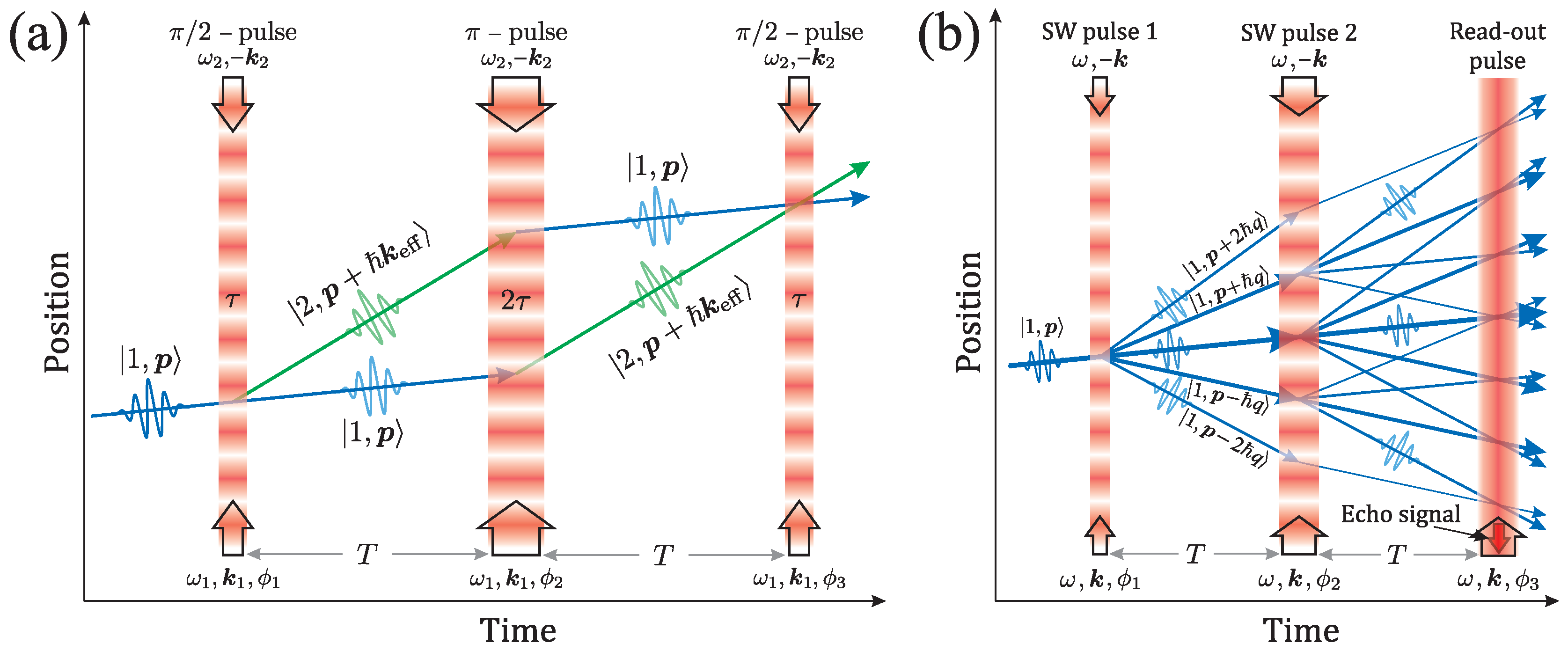
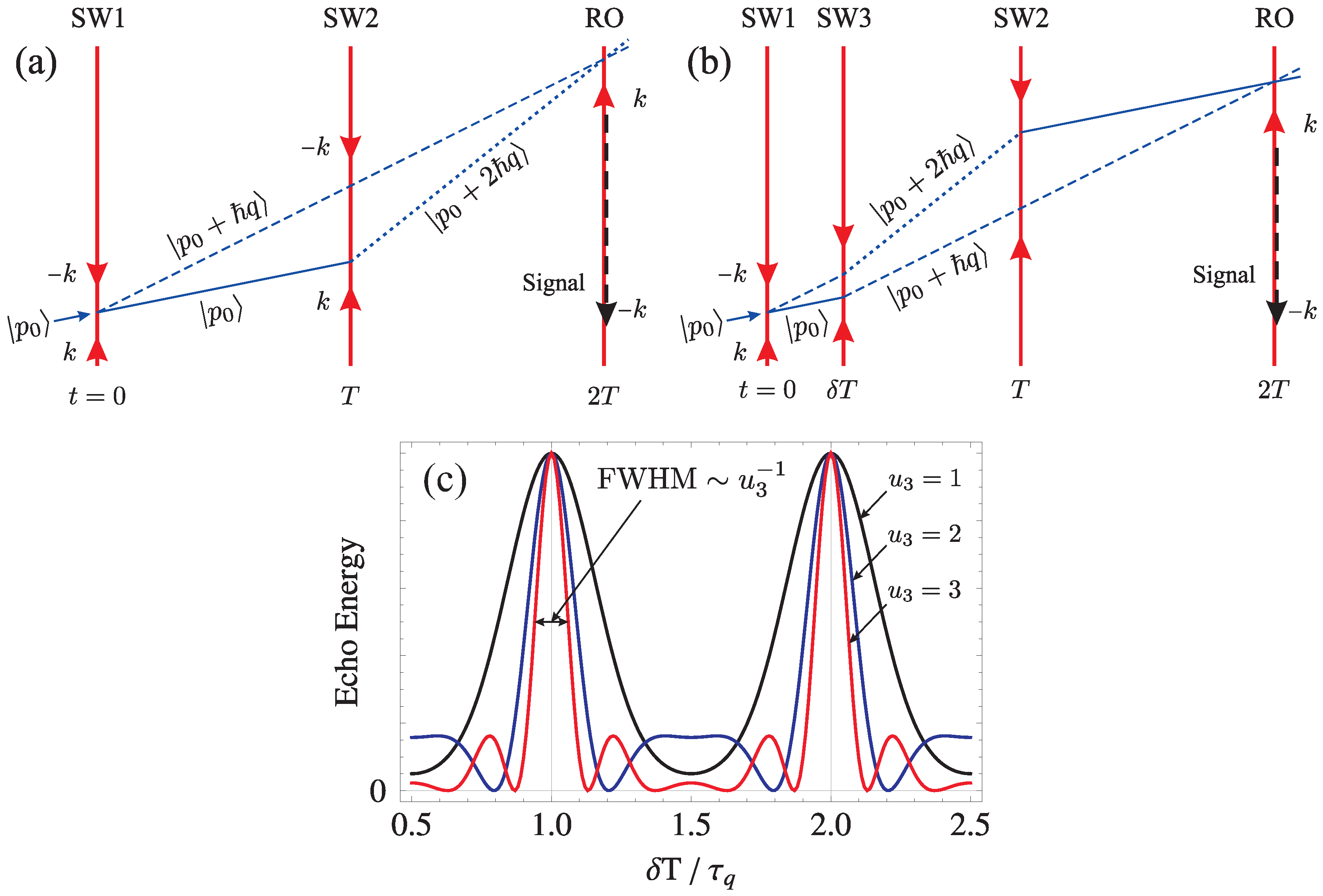
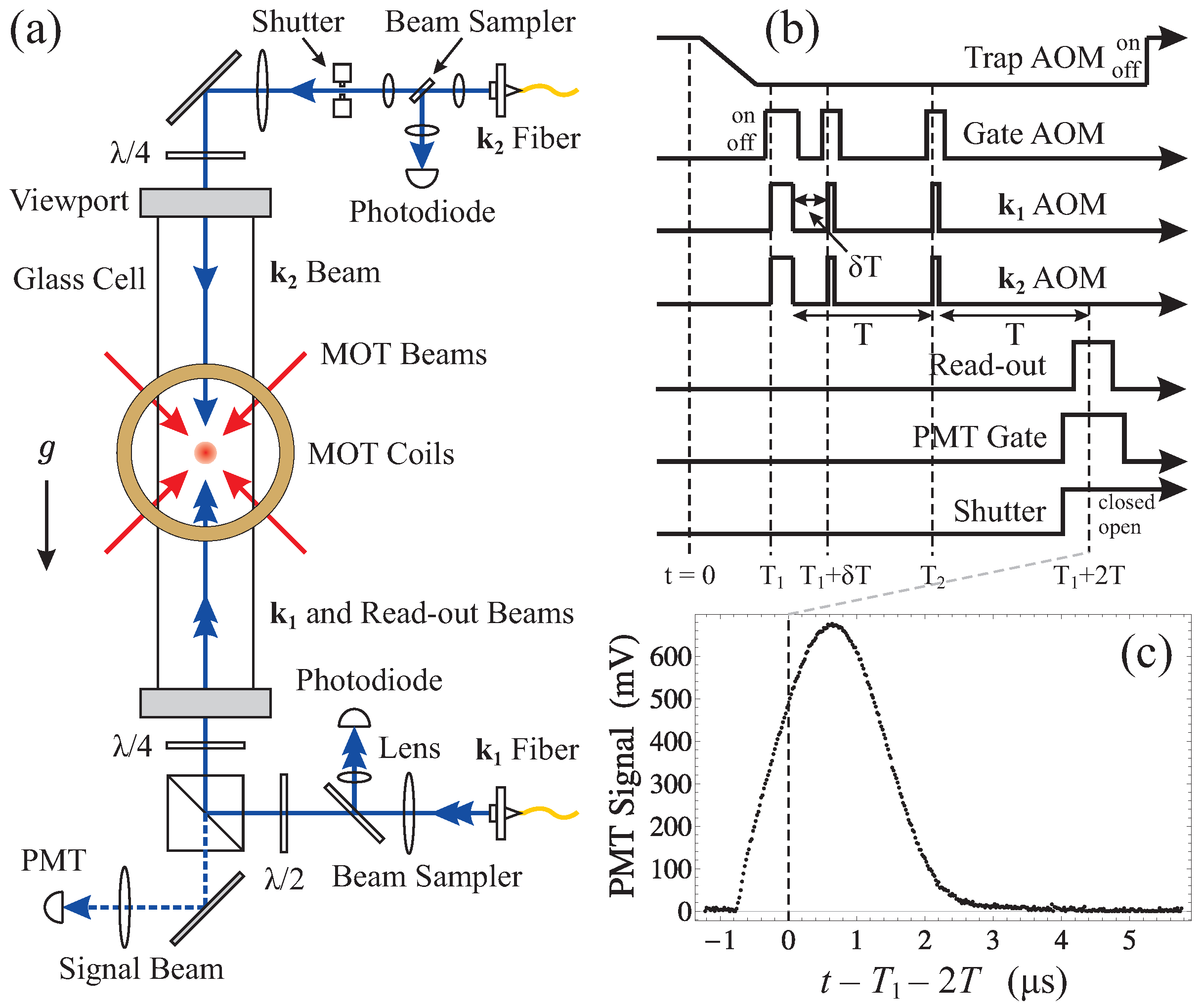

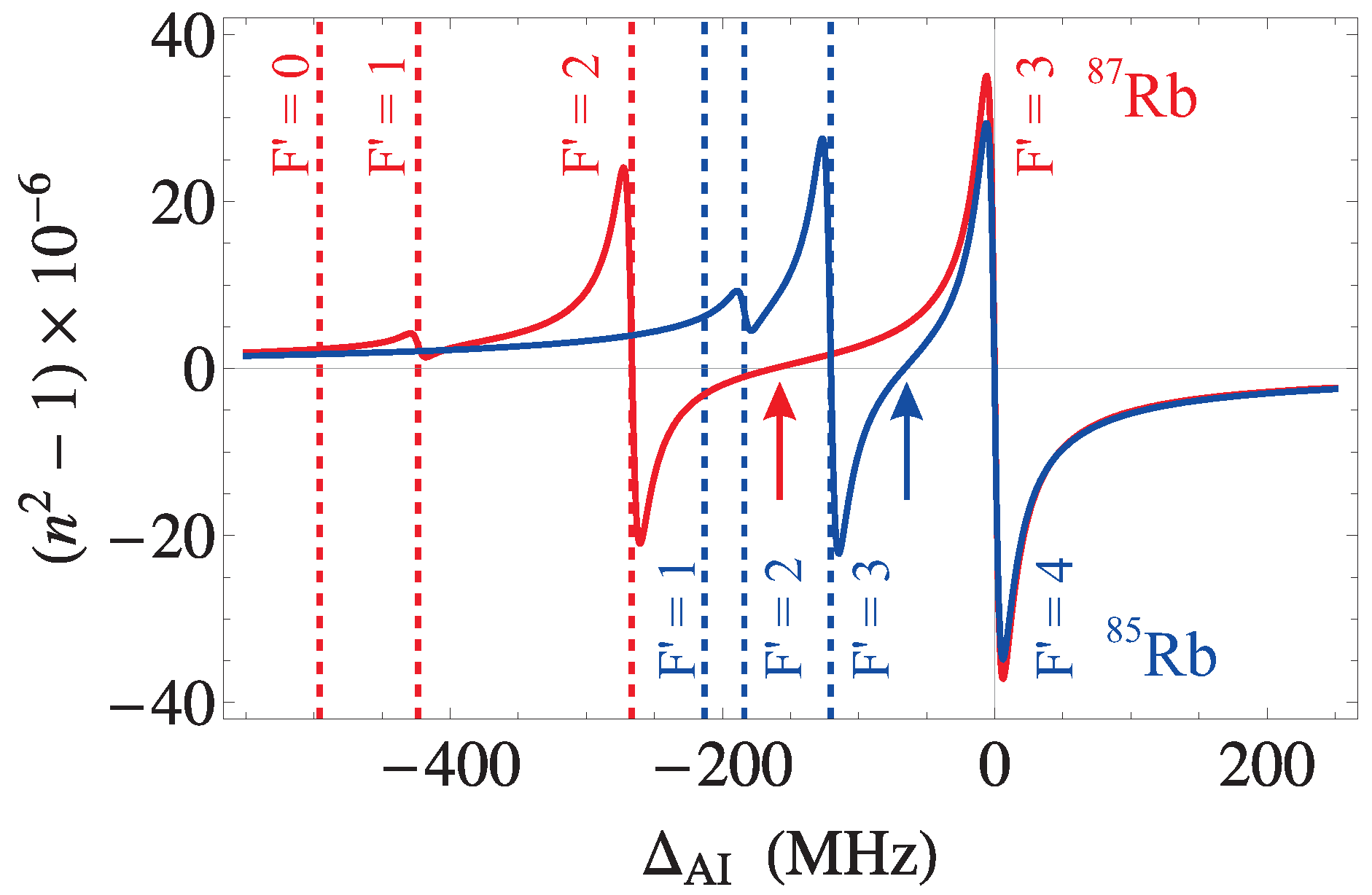
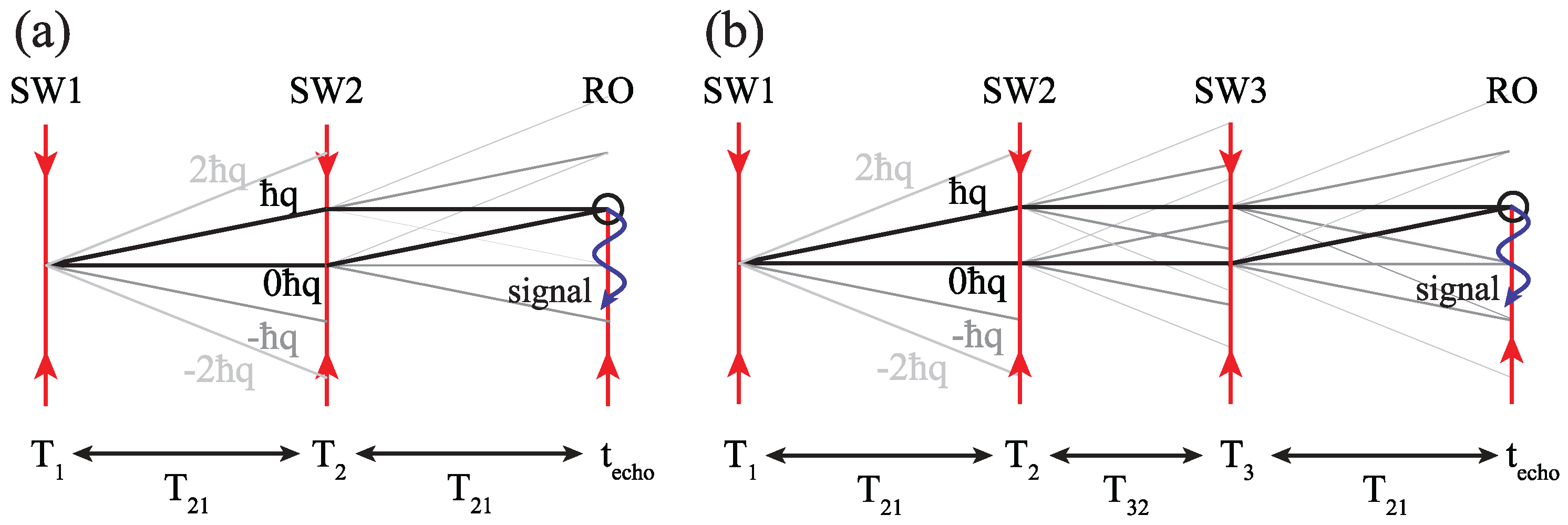
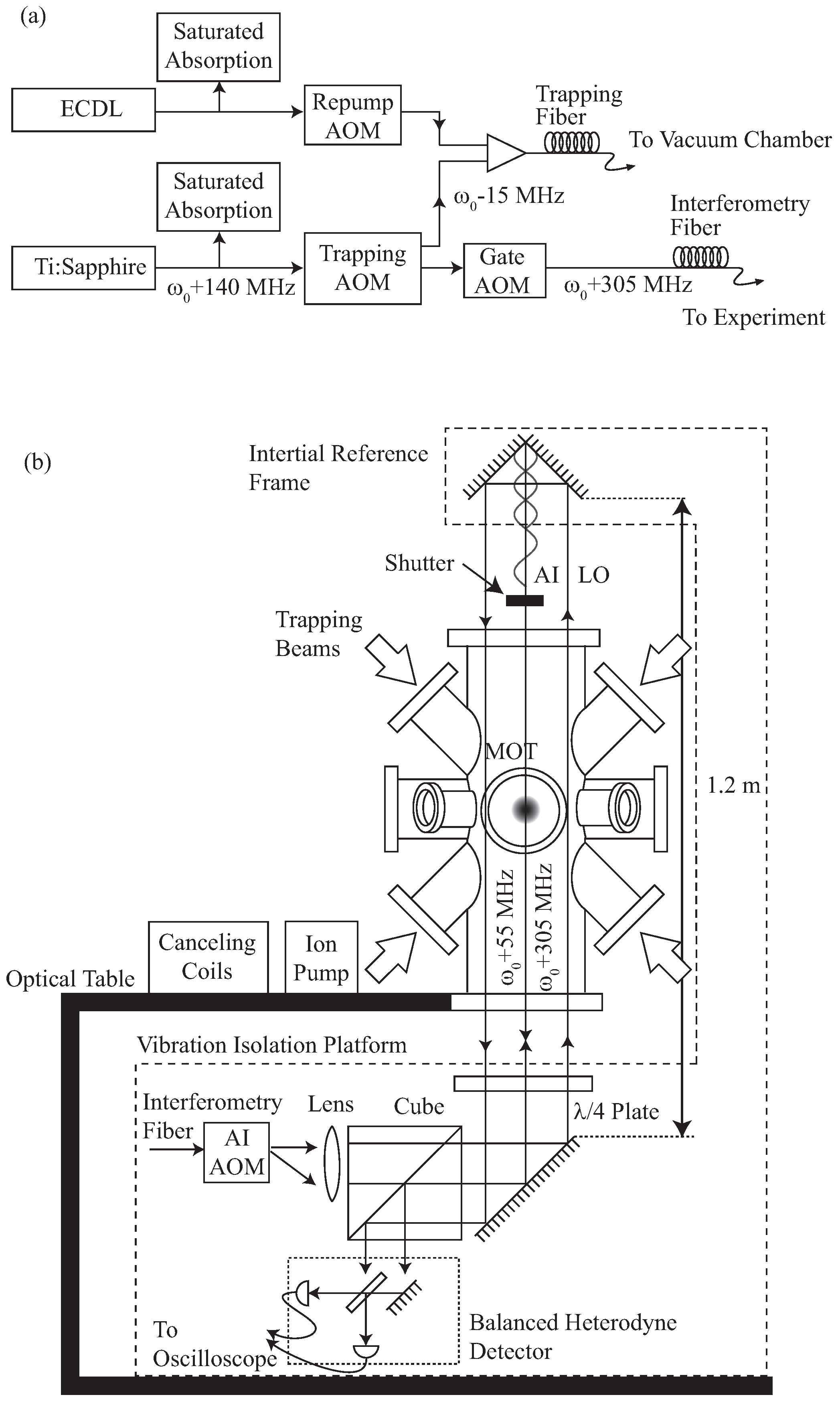
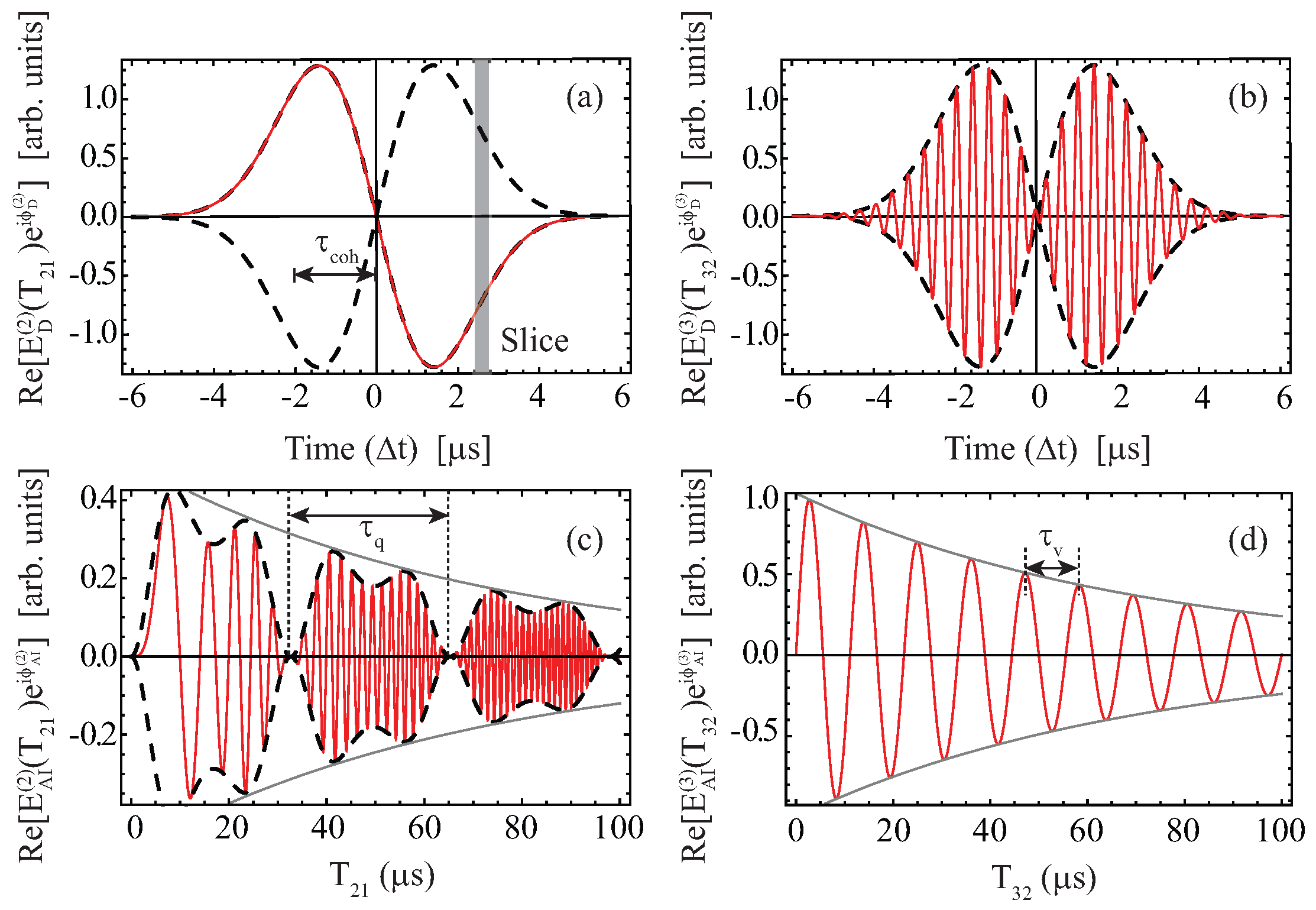

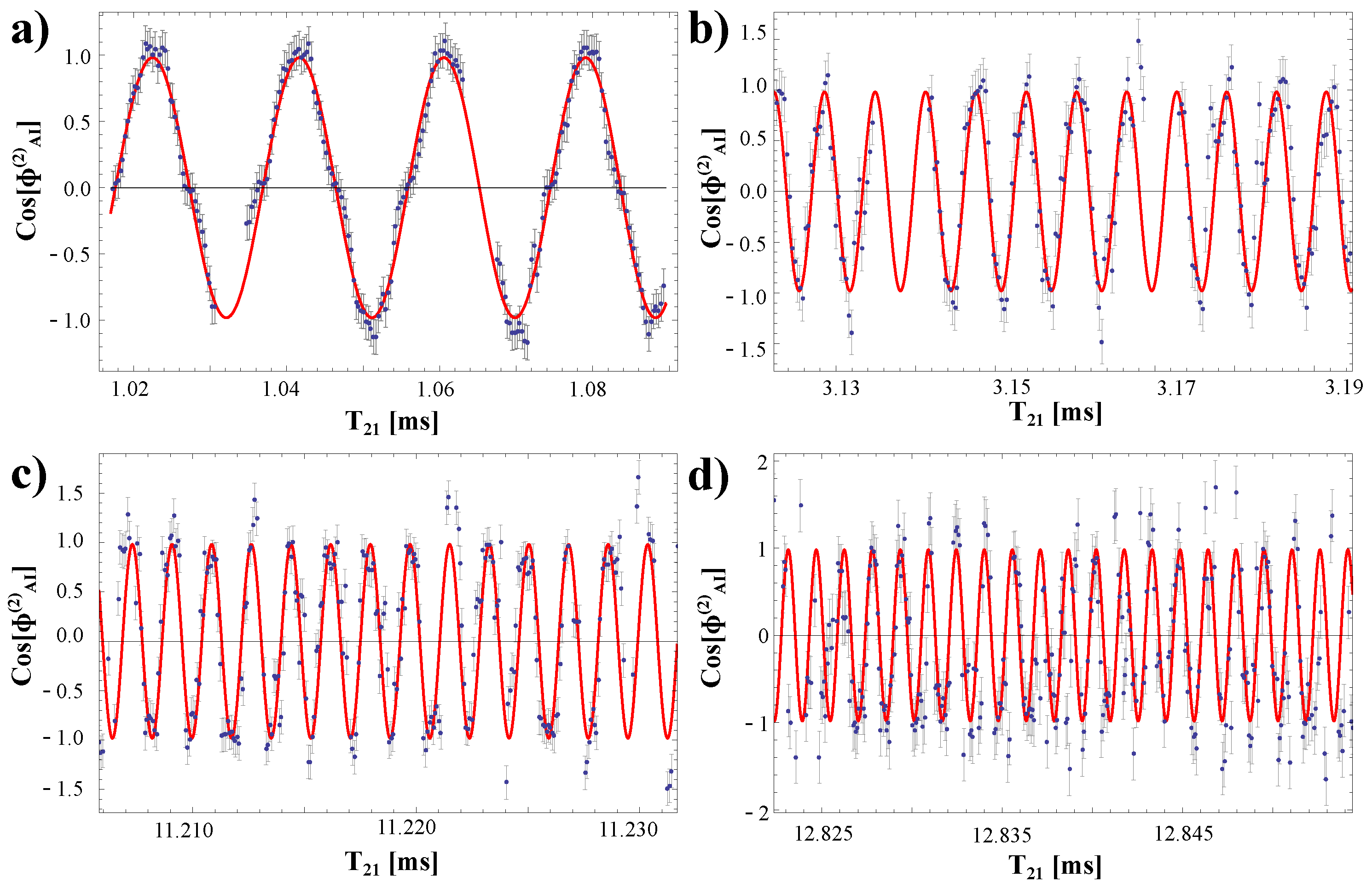

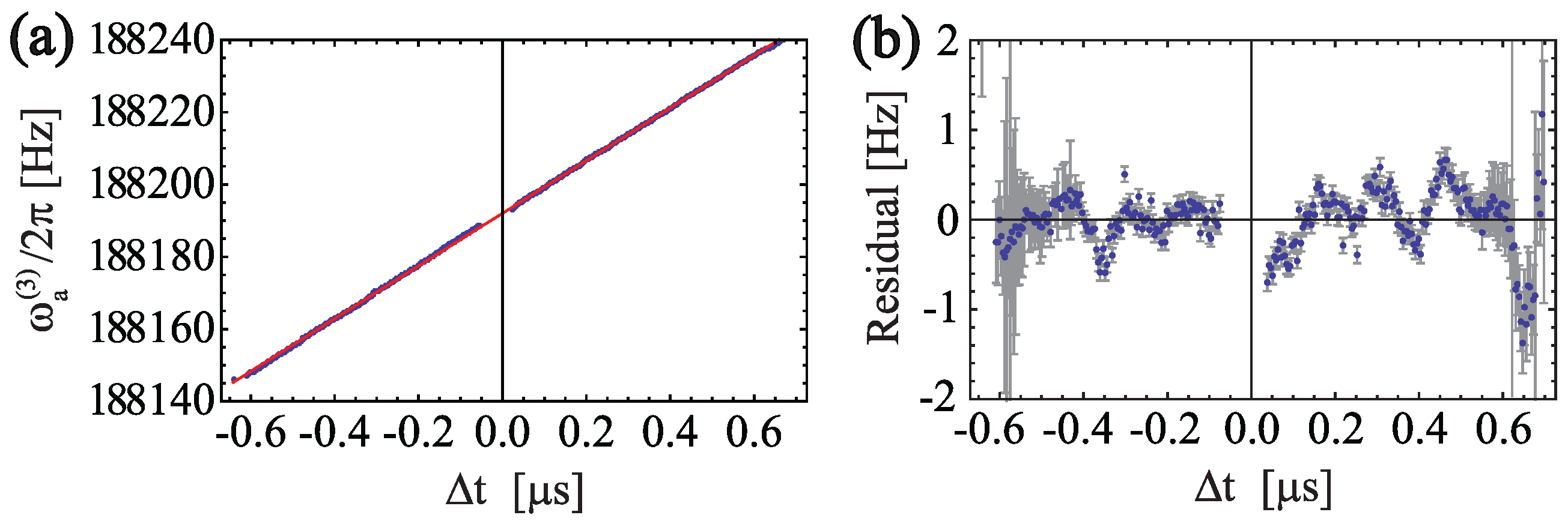
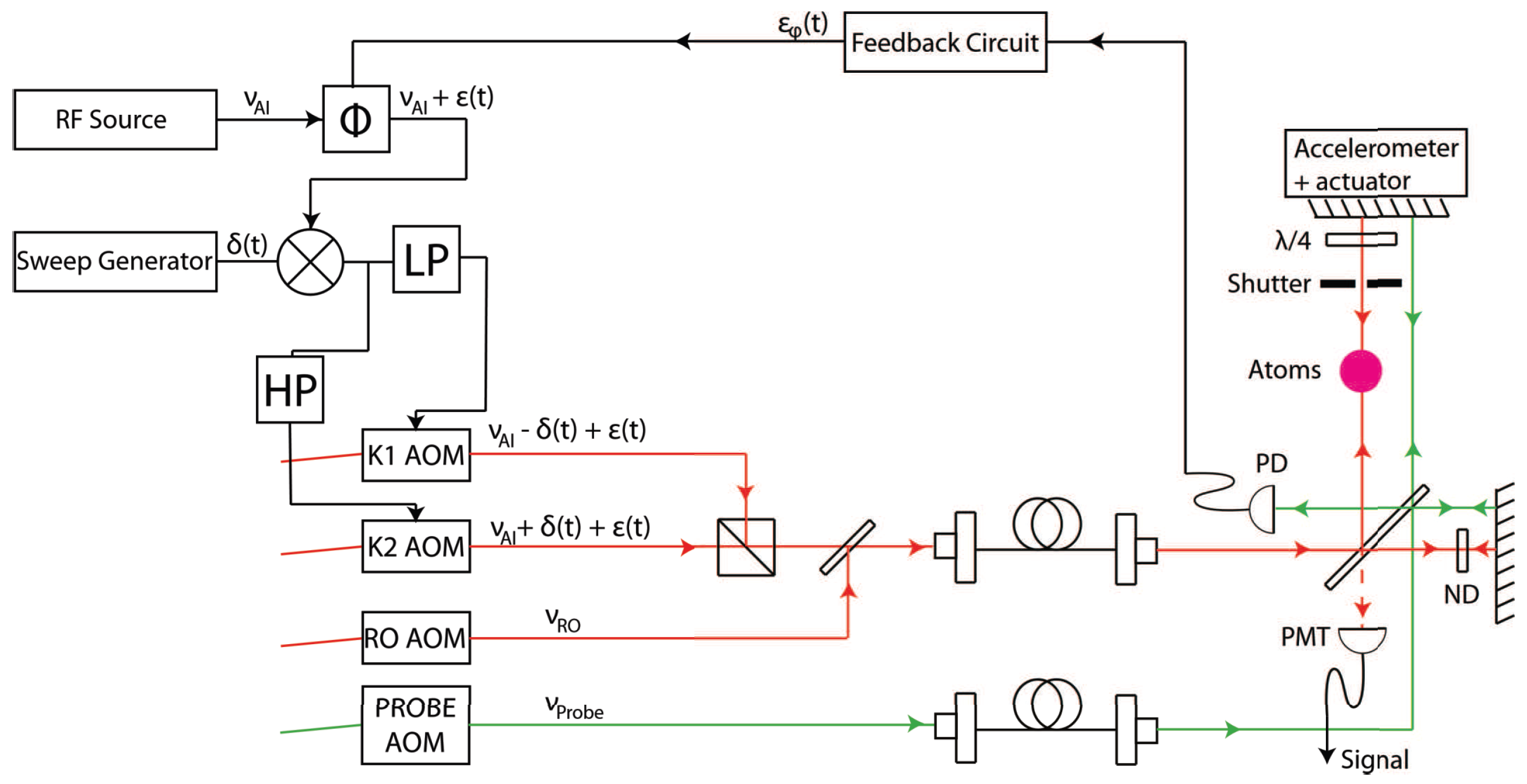
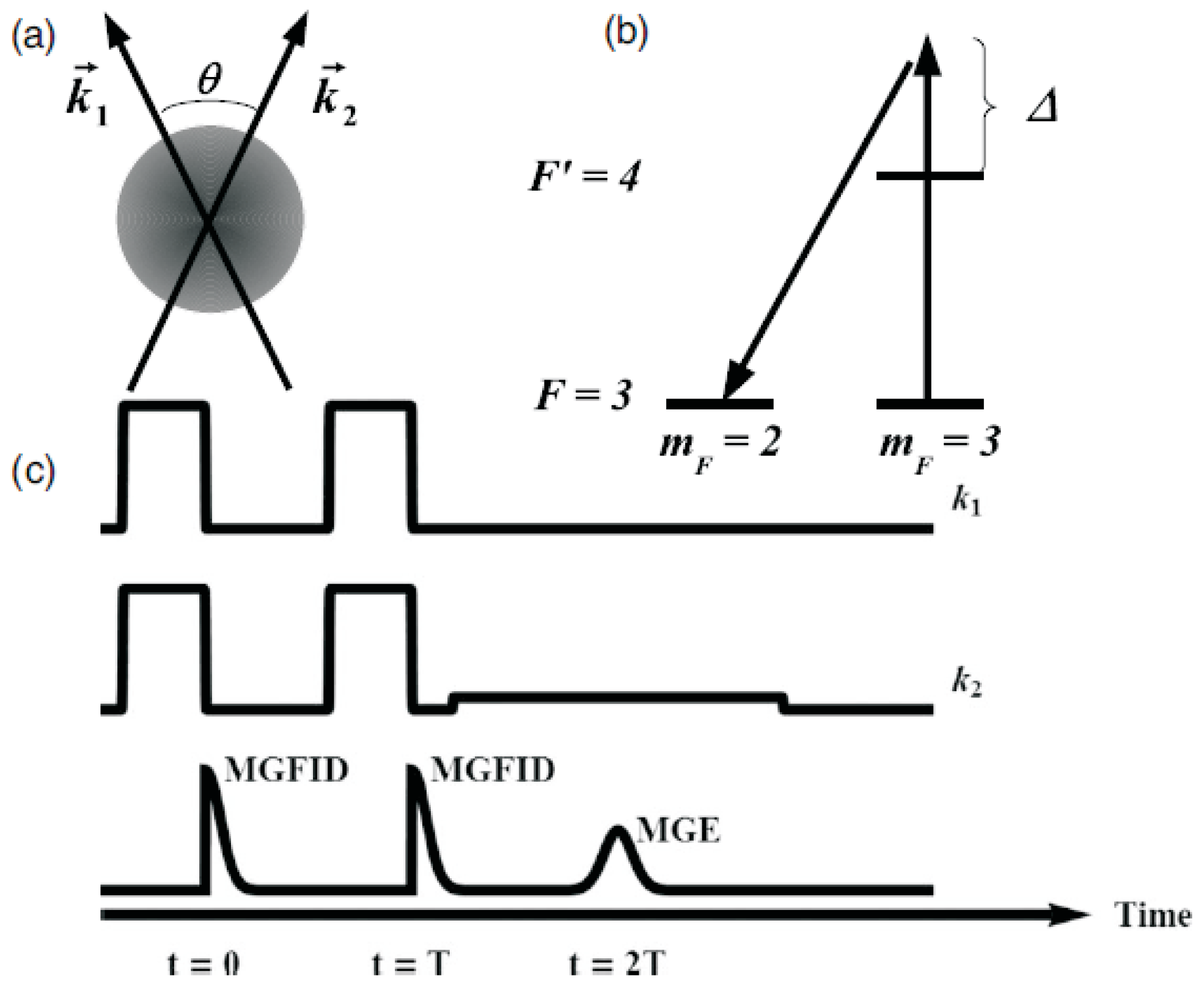
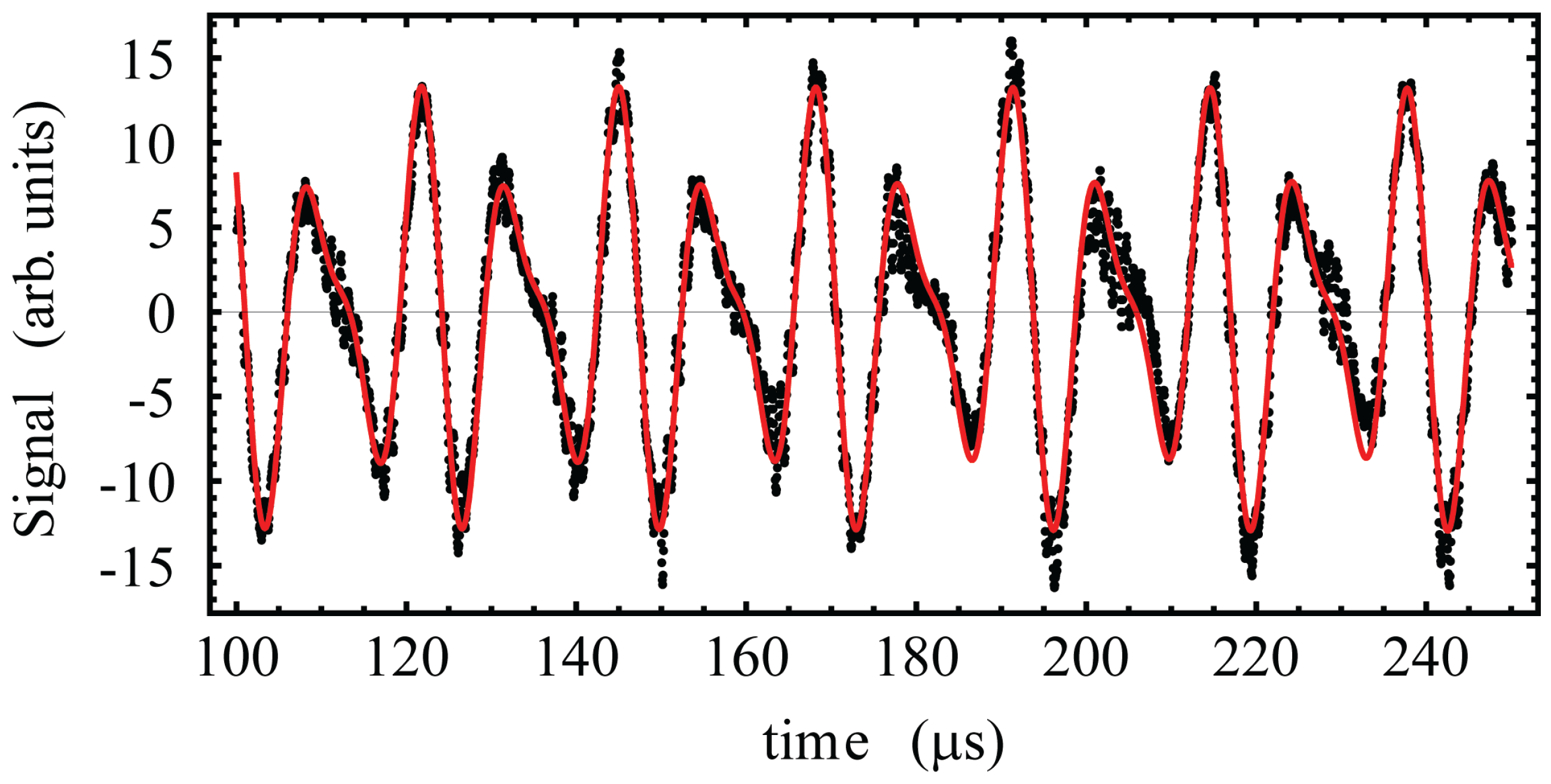

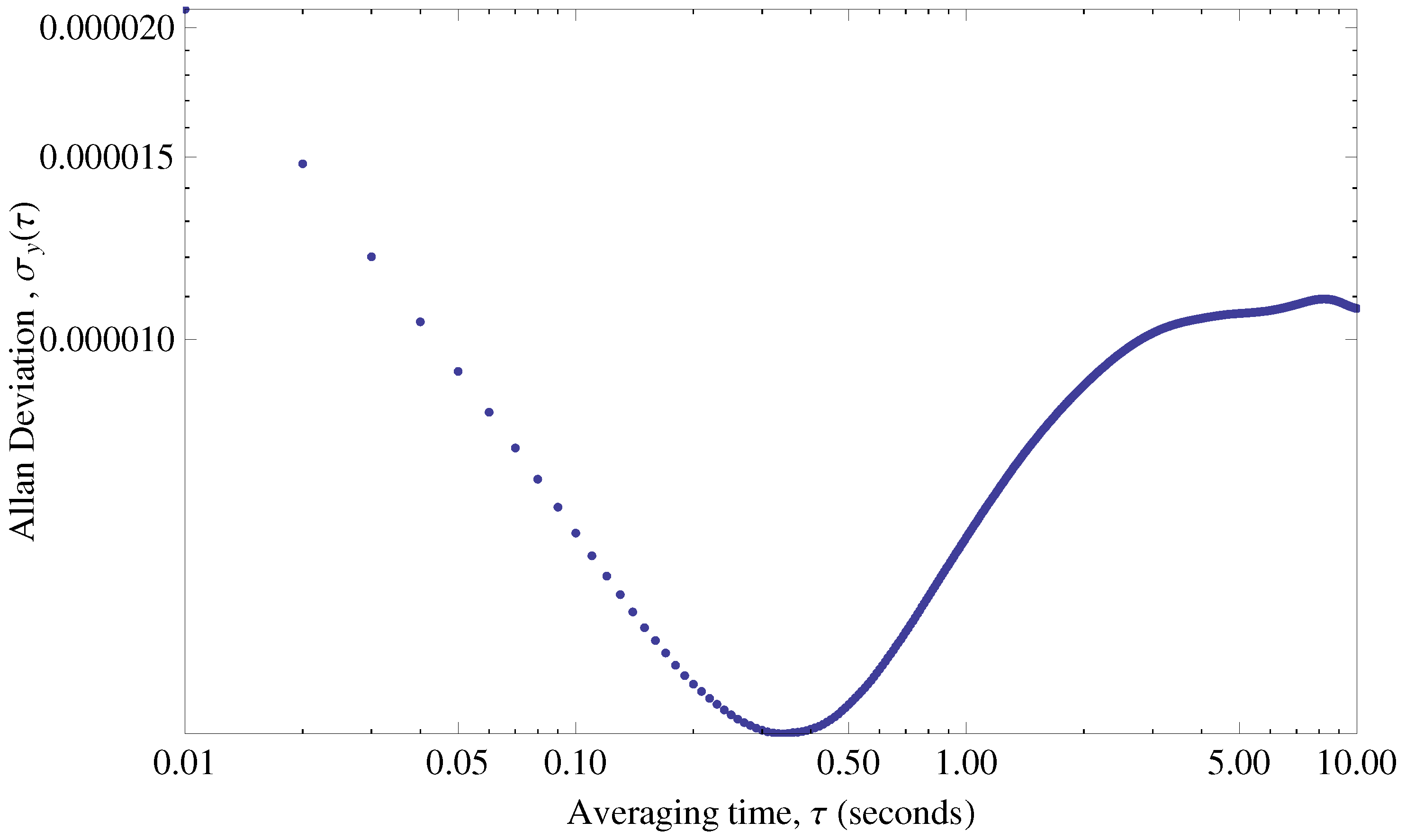
© 2016 by the authors; licensee MDPI, Basel, Switzerland. This article is an open access article distributed under the terms and conditions of the Creative Commons Attribution (CC-BY) license (http://creativecommons.org/licenses/by/4.0/).
Share and Cite
Barrett, B.; Carew, A.; Beica, H.C.; Vorozcovs, A.; Pouliot, A.; Kumarakrishnan, A. Prospects for Precise Measurements with Echo Atom Interferometry. Atoms 2016, 4, 19. https://doi.org/10.3390/atoms4030019
Barrett B, Carew A, Beica HC, Vorozcovs A, Pouliot A, Kumarakrishnan A. Prospects for Precise Measurements with Echo Atom Interferometry. Atoms. 2016; 4(3):19. https://doi.org/10.3390/atoms4030019
Chicago/Turabian StyleBarrett, Brynle, Adam Carew, Hermina C. Beica, Andrejs Vorozcovs, Alexander Pouliot, and A. Kumarakrishnan. 2016. "Prospects for Precise Measurements with Echo Atom Interferometry" Atoms 4, no. 3: 19. https://doi.org/10.3390/atoms4030019
APA StyleBarrett, B., Carew, A., Beica, H. C., Vorozcovs, A., Pouliot, A., & Kumarakrishnan, A. (2016). Prospects for Precise Measurements with Echo Atom Interferometry. Atoms, 4(3), 19. https://doi.org/10.3390/atoms4030019




